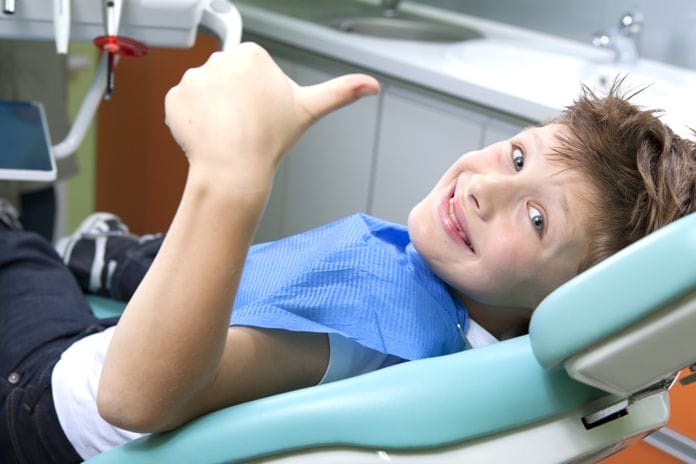As a pediatric dental hygienist, I am often asked “How can you work on kids?” and “WHY do you work in pediatrics?!” First and foremost, I love kids. I always have. When I was a little girl, I just wanted to be a mommy. Then I figured out that I needed to be able to support said children. Since teeth are cool, I decided to pursue dental hygiene. I was really excited to discover that there was a whole specialty that caters to only children. How awesome is that? My two favorite things wrapped up in one career. I have been in pediatrics for 21 of my 28+ years of being a hygienist. I work for two amazing dentists and an equally amazing orthodontist who has worked a miracle on my oldest daughter’s bite (a previous thumb sucker) and has made my other two children’s smiles even more amazing. Okay, enough bragging on my docs. Back to how to work on kids.
I have two sets of siblings that are children of hygienists. One mom works one day in an orthodontist office and then another in general practice. I love that the orthodontist hired a hygienist to work with his patients on oral hygiene! The other mom works in a periodontal practice. She always asks, “How can you work on kids?” In return, I ask her how she can work on smelly perio all day long? We laugh each time. The truth is, I’d rather work on a booger-nosed kid than a smelly perio smoker any day. Well, maybe minus the boogers. This is the only time I feel uncomfortable with children, only because I feel my peers are judging me. They probably don’t actually judge me; I am sure they are just glad that they don’t have to clean their own kids’ teeth. We also have several children of dentists that come to our office. For some reason, I don’t get as nervous with them because at least I never have to argue about bitewings or fluoride with these parents.
When pedo patients come in for their first visit, I enjoy getting them through it- even if there are tears. It is a sense of accomplishment when they leave with a smile on their face, wanting to come back for their next appointment. This brings me great joy and is a big part of my “why.” Parents are sometimes embarrassed about their child’s behavior. I can usually reassure them that this is typical behavior and that someday, their child will be an amazing patient.
How do I get them through the appointment, you ask? I am a big fan of tell-see-do. Before I have the patient sit in the dental chair, I take them to the brushing sink and disclose them. I show them the areas they are missing. Our disclosing agent is two-toned, so I explain the difference before I put it on. This way, they can’t justify the older plaque by telling me that it is there because they just ate lunch. For most patients, I teach them the circular motion of brushing. I remind them that they need to feel the brush tickling their gums so that they can get all of the germs. The parents are instructed to stand behind their child and use their own arms as an extension of their child’s arms.
When instructing about flossing, I usually have the parents help for as long as the child will let them. I show them proper technique, again with the parent behind the child. Either that or I suggest the patient lay in the parent’s lap and flossing them as if they are in my chair. Just like adults, children don’t like flossing. I tell them that the germs like to hide in between the teeth because they know that the toothbrush can’t get them there and that’s why we need to use floss to get them out of there.
Once in my chair, I take the “tooth counter” (explorer) and show it to them. I take the round end (never the pointy end- you never know when there will be a sudden move that could end in disaster) and count their fingernails. This is to show them that it will not hurt. I try not to say that it won’t hurt, I just say that we are just counting their teeth. Why do I have to count their teeth? Because I have to let the tooth fairy know how many teeth they have and if any are loose. That makes perfect sense, right? Sometimes I ask them to help me count, and I intentionally skip a number to see if they are paying attention, or ask them which number is next.
I do take a scaler to each tooth. I tell pedo patients that it is a “germ rubber” and that I am just going to rub the germs off of their teeth. If there is calculus, I take a scaling stroke. If there is just plaque, I just plaque debride. Some children present with a lot of plaque, and often, calculus on the lower posterior lingual. Other than the lower anteriors and upper posterior buccals, this is where I find the most junk. It is often overlooked during brushing.
Of course, next, I polish. I tell my patients it is a “tooth tickler.” I take the polisher and show them on their finger how it tickles. Sometimes kids don’t like the sensation of the polishing. Another thing that children often have an aversion to is flavors. We have many choices (about ten prophy paste flavors), but even then sometimes they can’t tolerate it. For these patients, I use a no-paste prophy angle. At the end of the appointment, I tell the patient that now that their teeth are clean, we need to make them strong. I tell them that we need to brush on some tooth vitamins (fluoride).
I think the main thing to remember when working with children is to remember that they are kids and not small adults. They don’t think like us. To work on kids, you need to talk to them on their level. Find out what’s going on in their life. For instance, what were you for Halloween, what did you ask for from Santa, what do you want for Hanukah, or whatever applies to the time of year it is.
I really do love working with children. If there is one problem, it would be that I have been at my office for so long that many of the scared little three-year-olds (or younger) I treated for their first prophy are now going off to college or aging out of the practice. It is amazing to get to see these kids grow into successful adults, but sad because I won’t get to see them anymore. Another aspect of working in a pediatric office that I enjoy is taking care of those with special needs. That will be a subject of another article. However, this is the population that has my heart.
Don’t be afraid of working on children. Just speak to them on their level. Avoid using big words. Use different, fun, and child-friendly words to describe your equipment. Be aware of some of the things that children don’t like such as sounds and flavors. Children are fun, and it can be very rewarding to treat them. I hope this helps a bit in treating our young patients.
SEE ALSO: 10 Expert Tips for Treating Pediatric Patients
RECOMMENDED: 10 Ways to Get Kids to Brush their Teeth & Have Fun Doing It











